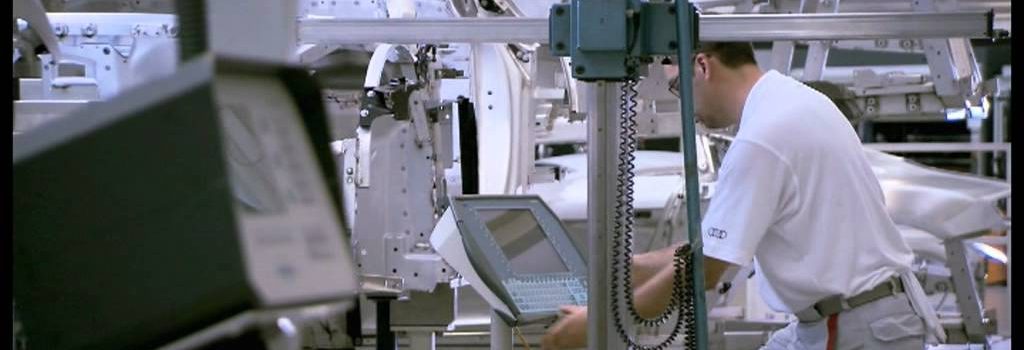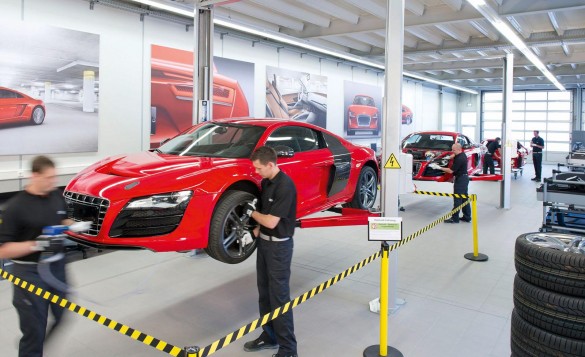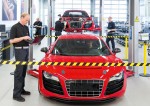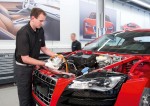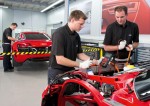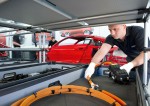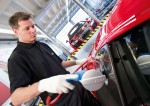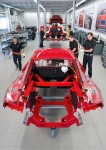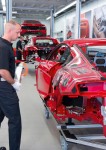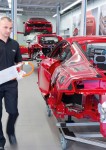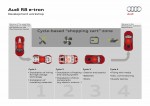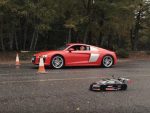Somehow portraying the meticulous build process of an exclusive sports car is suppose to be entertaining. I actually agree that it is, which is probably why Audi has released a ‘behind the scenes’ look at the Audi R8 e-Tron production.
Currently the new Audi R8 e-Tron is being built in a small pre-production run at the Neckarsulm, Germany Audi factory. The new R8 e-Tron will feature 308 horsepower (230 Kw) and 3,319 pounds-feet of torque from its 4 electric motors. The power is provided by a 53 KWh lithium-ion battery. This combination will accelerate the e-Tron from 0-62 mph in 4.8 seconds and top out at 155 mph.
Audi R8 e-Tron Press Release
Audi R8 e-tron: A look inside the development workshop
- quattro GmbH builds technology platform at satellite site in Biberach
- Werner Frowein, Managing Director of quattro GmbH: “The staff is highly skilled in small series production.”
The first all-electric Audi will be built at the Neckarsulm site, with a small production run of the R8 e-tron sports car to hit the roads in late 2012. quattro GmbH is currently building the first technology platform for the electric model at the Neckarsulm plant’s satellite site in Heilbronn-Biberach. Specially qualified employees are borrowing from the series production of the successful Audi R8 mid-engine sports car as they assemble the R8 e-tron at the development workshop.
The 122nd Annual General Meeting of AUDI AG in Neckarsulm gave business and product journalists their first opportunity to look inside the development workshop for the Audi R8 e-tron.“With the R8 e-tron, we are showing how inspiring electric mobility can be. Every system in this car has been tuned for maximum performance and range,” says Franciscus van Meel, Head of Electric Mobility Strategy at AUDI AG. “The R8 e-tron is a very important project for Audi because the competence and experience we glean from it will later flow into the large volume production of electric automobiles.” The expectation is that e-tron will become a synonym for advanced electric mobility, just as the term “quattro” today stands for pioneering all-wheel drive. “We want to be the leading premium manufacturer of electric vehicles by 2020,” says van Meel.
Systematic lightweight construction is one of the key preconditions for efficiency and range in electric vehicles. The Audi development engineers are therefore drawing on one of the company’s core competences for the R8 e-tron: The body is aluminum; thanks to Audi Space Frame technology (ASF), it weighs barely more than 200 kg (441 lb). The lightweight body is an important reason why the R8 e-tron weighs in at just 1,600 kg (3,527 lb).Employees at the Pre-Production Center in Neckarsulm and quattro GmbH are currently building the first technology platforms for the electric car. “The successful production of our Audi R8 high-performance sports car has given the employees of quattro GmbH a high level of competence in the area of small production runs and sports car manufacture,” explains Managing Director Werner Frowein.
The aluminum body of the technology platform is being built in conditions very close to those for volume production in the body shop for the R8 mid-engine sports car. Specific assemblies for the electric model, such as the center tunnel, are being produced by the Pre-Production Center in Neckarsulm. The R8 e-tron also goes through the coating process with the volume model. The technology platform is then sent to the satellite site in Heilbronn-Biberach for final assembly. “The production process is designed so that we can exploit synergy effects from R8 volume production,” explains Frowein.
For example, the sophisticated logistics concept that supplies the R8 factory with parts is also used for the body of the technology platform. Pre-picked components are delivered to the employees in “shopping baskets.” The parts are installed in the vehicles in a defined sequence in four cycles. “Small-series production places great demands on our employees,” says Frowein. This is why the development workshop is staffed with experienced employees who worked in R8 series production, where they gleaned key competence in small-series production.“The development workshop staff are specially qualified for high-voltage vehicles,” explains Andreas Heine, quattro GmbH project manager for the body of the R8 e-tron. They are trained in three stages – depending on their function and technical training – to work with the high-voltage technology. The basic level is sensitization for driving and working on high-voltage vehicles. The training then builds on this to qualify the workers as electronics experts for defined activities. Finally, the extended training as Certified Electronics Specialists for Automotive Technology provides the employees with the expertise required to perform the complete range of activities associated with high-voltage models.
AUDI AG is investing more than €5 billion in the two German sites at Ingolstadt and Neckarsulm between 2011 and 2015. A majority of this investment will flow into the development of new products and into future technologies such as electric and hybrid drive systems.
The future of mobility – the history of the Audi R8 e-tron
September 2009 Audi presents the e-tron high-performance sports car with all-electric drive at the Frankfurt Motor Show. With 230 kW (313 hp) and 4,500 Nm (3,319 lb-ft) of torque, the two-seater accelerates from 0 to 100 km/h (62 mph) in 4.8 seconds.June 2010 quattro GmbH in Neckarsulm is chosen to build the R8 e-tron because of its competence in the areas of small-series production and the manufacture of high-performance sports cars.
July 2010 The Audi R8 e-tron wins the Silvretta E-Auto Rally. The two-seater beat 23 other electric cars in the three-day race covering 167.5 kilometers (104 miles).
[source: Worldcarfans]
